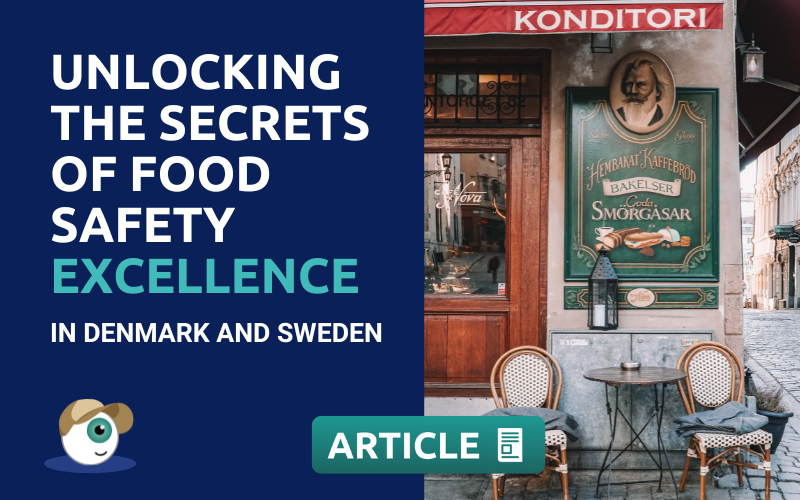Unlocking the Secrets of Food Safety Excellence in Denmark and Sweden

When it comes to food safety management, few nations shine brighter than Denmark and Sweden.
Consistently ranking among the top performers in indices like the Food Sustainability Index and the Global Food Security Index, these countries offer a masterclass in safeguarding consumers’ plates.
But what lies behind their exceptional performance?
Exploring the intricate tapestry of regulations, innovative practices, and unwavering commitment to safety that permeates their food service industries can unlock valuable insights and inspire emulation for countries and businesses worldwide.
In this article, we unveil the secrets of Denmark and Sweden’s food safety excellence.
By understanding the key pillars of their food safety excellence, we hope to empower stakeholders across the globe to replicate this success and cultivate a safer, more secure food landscape for all.
What does Food Safety Excellence look like?
“Food Safety Excellence” is a term used to describe a set of practices and approaches that go beyond merely adhering to basic regulations and instead strive for the highest possible level of food safety, exceeding minimum requirements and continuously seeking improvement.
It’s not just about preventing bad things from happening but actively creating a culture of safety throughout the food system.
Here are some key features of “Food Safety Excellence”:
- Proactive and preventative: Rather than solely reacting to problems, excellence prioritises preventing them through meticulous planning, risk assessments, and implementation of robust control measures.
- Data-driven decision-making: Decisions are based on evidence and analysis of food safety data, not just tradition or assumptions.
- Continuous improvement: There’s a constant drive to learn, adapt, and implement new technologies and best practices to enhance safety measures.
- Transparency and communication: Open communication throughout the supply chain and clear information for consumers build trust and confidence.
- Collaboration and partnerships: Sharing knowledge and resources between stakeholders – government, industry, academia – fosters collective progress.
- Investment in training and education: Empowering all personnel with proper food safety knowledge and skills is paramount.
In the context of Denmark and Sweden, their “Food Safety Excellence” translates to practices like:
- Stringent regulations: Stricter than EU minimums, ensuring comprehensive coverage and rigorous enforcement.
- Advanced traceability systems: Allowing quick identification and recall of potentially contaminated products.
- Strong focus on hygiene and sanitation: From farm to fork, robust practices minimise pathogen risks.
- Innovation in technology: Utilising innovative solutions for temperature control, monitoring, and data analysis.
- Consumer-centric approach: Clear labelling, allergen information, and open communication build trust.
Food Safety Excellence: Rankings
Sweden and Denmark consistently show high performance in food safety as proven in a number of different rankings based on a comprehensive assessment of factors like affordability, availability, quality, safety, and sustainability within a country’s food system.
This underscores the effectiveness of their food safety practices.
- Food Sustainability Index (FSI) 2023: Both Denmark and Sweden ranked in the top 10, with Denmark at 3rd and Sweden at 7th. (Source: The Economist Intelligence Unit)
- Global Food Security Index (GFSI) 2023: Denmark secured 2nd place, trailing only Ireland, while Sweden closely followed at 4th. (Source: Economist Intelligence Unit)
- Foodborne Diseases Burden Index (FDBI): This index, developed by the World Health Organization (WHO), estimates the burden of foodborne diseases in different countries based on mortality and disability-adjusted life years (DALYs). While not explicitly ranking countries, it gives insights into their food safety performance.
Both Denmark and Sweden have relatively low FDBI scores, indicating a lower burden of foodborne illness.

Is HACCP mandatory in Denmark and Sweden?
HACCP is mandatory in both Denmark and Sweden for foodservice businesses. However, there are some differences in the specific regulations and implementation details between the two countries.
Here’s a breakdown:
Denmark:
- Regulation: Based on Regulation (EC) No 852/2004 of the European Parliament and of the Council on the hygiene of foodstuffs.
- HACCP: Mandatory for all food businesses, including restaurants, cafes, catering companies, etc.
- Control and enforcement: Danish Veterinary and Food Administration (DVFA) conducts inspections and enforces regulations.
- Specific HACCP rules: Defined in the Danish Statutory Order on the Hygiene of Foodstuffs (Bekendtgørelse om fødevarehygiejne) and applicable to all food businesses in Denmark, regardless of size or type.
Following the seven principles of HACCP kitchen teams are expected to:
- Identify hazards: Requires businesses to identify all potential biological, chemical, and physical hazards in their food operations.
- Determine critical control points (CCPs): Pinpoints specific steps in the process where hazards can be prevented, eliminated, or reduced to safe levels.
- Establish critical limits for each CCP: Defines acceptable thresholds for parameters like temperature, time, or pH at each CCP.
- Monitor CCPs: Implements procedures to continuously monitor CCPs and ensure they stay within critical limits.
- Take corrective actions: Defines actions to be taken if critical limits are breached to regain control and prevent harm.
- Verification procedures: Establishes methods to verify the effectiveness of the HACCP plan, including record-keeping and internal audits.
- Documentation and records: Mandates maintaining comprehensive documentation of the HACCP plan, monitoring records, and corrective actions taken.
Additional Requirements:
- Risk assessment: Requires a written risk assessment to identify specific hazards and their likelihood of occurrence.
- Prerequisite programs: Implementation of prerequisite programs like good hygiene practices (GHPs) and good manufacturing practices (GMPs) to create a foundation for HACCP.
- Training: Food handlers must receive training on HACCP principles and their specific roles in the HACCP plan.
- Competent person: Appointing a competent person responsible for overseeing and updating the HACCP plan.
- Traceability: Maintaining records to trace food products throughout the supply chain.
- Notification: Mandatory notification of foodborne illness outbreaks to authorities.
- Resources: Danish Veterinary and Food Administration (DVFA): https://fvm.dk/
Sweden:
- Regulation: Also based on Regulation (EC) No 852/2004. In Sweden, the specific rules for implementing HACCP are outlined in two key documents:
- Swedish Food Act (livsmedelslagen): Establishes the legal framework for food safety in Sweden, including the requirement for food businesses to implement HACCP where necessary.
- Swedish Food Ordinance (livsmedelsordningen): Provides detailed regulations on HACCP principles and their application.
- HACCP: Similar to Denmark, HACCP is mandatory for all food businesses in Sweden, except for businesses selling pre-packaged food if there’s no risk of contamination during handling. This emphasises Sweden’s commitment to proactive food safety across the board.
- Control and enforcement: Swedish National Food Agency (Livsmedelsverket) conducts inspections and enforces regulations.
- Specific HACCP rules: Defined in the Swedish Food Act (livsmedelslagen) and the Swedish Food Ordinance (livsmedelsordningen).
- Structure: Like Denmark, Sweden follows the seven HACCP principles:
- Hazard identification: Requires businesses to identify potential biological, chemical, and physical hazards specific to their operations.
- CCP determination: Pinpoints critical control points where hazards can be controlled.
- Critical limits: Defines acceptable thresholds for parameters like temperature, time, or pH at each CCP.
- Monitoring: Implements procedures for continuous monitoring of CCPs.
- Corrective actions: Defines actions to take if critical limits are breached.
- Verification: Establishes methods to verify the effectiveness of the HACCP plan.
- Documentation: Mandates maintaining comprehensive documentation of the HACCP plan and its implementation.
- Key Differences from Denmark:
- Flexibility: The Swedish Food Ordinance adopts a more flexible approach compared to the Danish order. While outlining the same principles, it allows for some adaptation based on the specific business and risks involved.
- Exemptions: Pre-packaged food with minimal handling risks is exempt from mandatory HACCP, unlike Denmark’s blanket requirement.
- Prescriptive details: Compared to Denmark, the Swedish regulations focus less on prescriptive details and more on achieving the desired outcomes through effective hazard control.
- Additional Requirements:
- Risk assessment: Like Denmark, a written risk assessment is required to identify and prioritise hazards.
- Prerequisite programs: Implementation of GHPs and GMPs remains crucial for a solid foundation.
- Training: Food handlers must receive HACCP training tailored to their roles and responsibilities.
- Competent person: Similar to Denmark, appointing a competent person to oversee and update the HACCP plan is necessary.
- Traceability: Maintaining records to trace food products throughout the supply chain is mandatory.
- Notification: Reporting foodborne illness outbreaks to authorities is required.
- Resources: Swedish National Food Agency website: https://www.livsmedelsverket.se/
Deep Dive into Food Safety Regulations in Denmark and Sweden
While HACCP forms the foundation for food safety practices -and therefore food safety excellence – in both Denmark and Sweden, a myriad of additional regulations govern specific aspects of foodservice operations.
Let’s delve deeper into each area:
- Food Premises Design and Hygiene:
- Denmark: Requires specific layouts for food preparation areas, with separate designated zones for raw and cooked food to prevent cross-contamination. Hygiene regulations mandate regular cleaning and disinfection procedures.
- Sweden: Similar in principle, with detailed specifications for hygiene measures, ventilation systems, and waste disposal. Additionally, regulations outline proper storage and handling practices for various types of food.
- Temperature Control:
- Both countries: Implement strict temperature control guidelines for different food groups throughout storage, preparation, and serving stages. Specific temperature ranges are defined for chilling, freezing, and hot holding to ensure food safety and prevent bacterial growth.
- Denmark: Emphasises monitoring systems and documentation of temperature data.
- Sweden: Focuses on proper handling practices and equipment calibration.
- Allergen Labelling:
- Both countries: Require clear and accurate labelling of allergens (e.g., gluten, nuts, dairy) on menus and pre-packaged products. Training of staff on allergen management is crucial to ensure accurate communication with customers.
- Denmark: Implements stricter regulations with specific font size and placement requirements for allergen information.
- Sweden: Offers guidance on best practices for allergen management but allows more flexibility in presentation.
- Traceability and Recall Procedures:
- Both countries: Mandate robust systems for documenting the origin and movement of food ingredients throughout the supply chain. This facilitates rapid identification and recall of potentially contaminated products.
- Denmark: Requires detailed records of suppliers, purchase dates, and quantities for each ingredient.
- Sweden: Focuses on establishing clear communication channels between suppliers and food businesses for effective recall implementation.
- Training of Food Handlers:
- Both countries: Require all food handlers to receive training on safe food handling practices, including personal hygiene, proper cooking techniques, and cross-contamination prevention.
- Denmark: Offers government-approved training programs and certification schemes.
- Sweden: Emphasises workplace-based training programs tailored to specific business needs.
Food Safety Inspections in Denmark and Sweden: Transparency and Public Trust
Both Denmark and Sweden prioritise transparency and public access to information around food safety inspections.
Here’s a quick comparison:
Denmark:
- Inspection frequency: Food businesses are inspected based on risk assessments, with high-risk businesses facing more frequent inspections.
- Inspection reports: All inspection reports are publicly available online, allowing consumers to assess the hygiene standards of any foodservice establishment.
- Grading system: While not a formal score, the reports use terminology like “satisfactory,” “needs improvement,” or “unsatisfactory” to indicate compliance levels.
- Display requirements: Businesses are not required to display inspection reports, but many choose to do so voluntarily as a mark of pride and transparency.
Sweden:
- Inspection frequency: Similar to Denmark, inspections are risk-based.
- Inspection reports: Not directly accessible to the public. However, summaries of inspection results are available online, indicating if a business adheres to food safety regulations.
- Grading system: No formal grading system is used.
- Display requirements: Businesses are not required to display inspection results.
In their pursuit of food service excellence, both countries emphasise risk-based inspections, focusing on establishments with higher potential for food safety issues, and prioritise transparency through online access to inspection reports or summaries.
Both Denmark and Sweden’s commitment to open information fosters public trust and incentivises businesses to maintain high food safety standards.
Denmark and Sweden’s exemplary food safety record serves as a powerful inspiration for countries and businesses worldwide.
Their success stems from a robust foundation of regulations, unwavering commitment, and – crucially – leveraging cutting-edge technology.
This is where Andy, the leading food safety digital assistant, steps in.
Just like Denmark and Sweden prioritise proactive measures and data-driven decision-making, Andy empowers you to do the same.
Here’s how Andy can elevate your food safety to new heights:
- Automated HACCP: Streamline compliance with the seven HACCP principles through automated tasks, digital records, and real-time monitoring.
- Enhanced Traceability: Gain instant visibility into your supply chain with detailed ingredient tracking, preventing contamination and facilitating swift recalls.
- Temperature Control Mastery: Eliminate guesswork with precise temperature monitoring and automatic alerts, ensuring food stays safe at all stages.
- Allergen Management Simplified: Ensure accurate allergen labelling and staff training with intuitive tools and resources, protecting your customers.
- Training at Your Fingertips: Equip your team with essential food safety knowledge through engaging online training modules accessible anytime, anywhere.
- Transparency Champion: Foster trust and build brand reputation with easy access to inspection reports and clear communication to your customers.
Ready to join the journey towards food safety excellence?
Experience Andy for FREE for 10 days and witness the transformative power of technology in safeguarding your food, your customers, and your brand.
👉🏽 Click here to start your free trial 👈🏽


